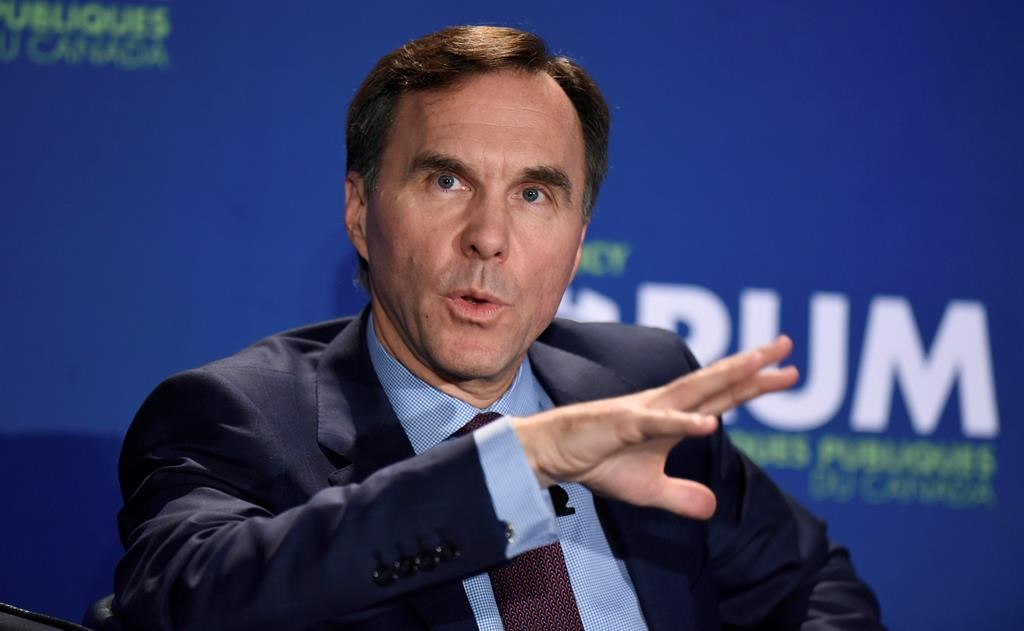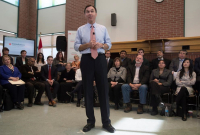When Finance Minister Bill Morneau meets a group of private−sector economists Thursday to ask about their economic forecasts, he may be encouraged to shed a little light on the future himself.
Morneau will sit down with experts in Toronto to seek their projections and opinions ahead of the government’s fall economic and fiscal update, which is expected in the coming weeks.
Scotiabank’s chief economist, a former senior Finance Department official under Morneau, plans to ask his old boss about something he says is lacking from the feds: a clear fiscal road map.
"Right now, there isn’t really a plan," said Jean−Francois Perrault, who was assistant deputy minister of economic and fiscal policy until the end of 2015.
"They’ve not really given any clarity as to how they think about fiscal policy and government debt going forward."
In its March budget, the Liberal government included new spending commitments aimed at helping the economy grow. The document predicted five−straight budgetary deficits that could add more than $110 billion to Canada’s public debt, beginning with a $29.4−billion shortfall this year.
But it didn’t include a blueprint outlining when or how these shortfalls would eventually be eliminated.
Citing a weaker−than−anticipated economy, the Liberals abandoned several firm fiscal benchmarks they played up during last year’s election campaign — sometimes referred to as "anchors."
The budget put them on track to ditch pledges to: run annual deficits of no more than $10 billion; to balance the books in four years; and to reduce the debt−to−GDP ratio — also known as the debt burden — in each year of their mandate to 27 per cent.
Morneau said at the time that Ottawa’s spending decisions would be guided by economic growth, rather than precise fiscal markers. He also pointed to his budget’s revised prediction that the debt−to−GDP ratio would be lower than current levels in five years, to 30.9 per cent.
On Wednesday, Morneau reiterated during an event in Ottawa that the government would be "fiscally responsible."
"We’re going to maintain that objective to have fiscal anchors," Morneau said during a public policy conference. He did not elaborate on potential markers.
"As we put out our fiscal update this fall, Canadians will get a better sense of where we stand and how we’re going to make an impact."
Perrault thinks Ottawa should provide more information about its goals when it comes to the federal bottom line. The government must show that the shortfalls are temporary, set an objective to be met over time and lay out how it will get there, he said.
"I think that stuff is pretty important to give a sense to markets that deficits aren’t going to be $30 billion forever," said Perrault, who added he doesn’t hold strong views as to what the objective should be.
He also noted the Liberals still have election spending promises that have yet to be costed.
Craig Alexander, chief economist for the Conference Board of Canada, said even in a low−rate environment a government can’t run deficits indefinitely.
"They do come with a cost," said Alexander, whose organization will be represented at the meeting by deputy chief economist Pedro Antunes because of a scheduling conflict.
"A responsible fiscal path is also to make a commitment to balance the books down the road."
Alexander also said while the debt−to−GDP ratio is good for illustrating Canada’s fiscal capacity, he didn’t think it made a strong fiscal anchor. Governments have some control over how big their deficits are, but have limited command over GDP, he said.
BMO chief economist Doug Porter, who will attend the meeting, said he plans to "counsel patience" when it comes to looking for the effects of spending Ottawa has already committed to as an economy−booster.
"Some of the measures that they’ve announced have yet to fully kick in and I think just the history of the past year shows that there’s only so much that fiscal spending can do," said Porter, who added he had no immediate concerns about the lack of a timeline to return the books to balance.
Porter said he believes the debt−to−GDP ratio is a good anchor. He also said it’s important for governments to have some flexibility.
Economists expect to present Morneau with outlooks that are weaker than the forecasts they made in the weeks before last spring’s budget. Ottawa, they said, should expect the downgrades to chew into the government’s bottom line.
In March, Morneau added a $6−billion risk adjustment to his fiscal projections in case the economy underperformed. Several economists have predicted that between $2 billion and $3 billion of the contingency reserve will be used up because of lower growth.
The key for experts like RBC’s chief economist is what Morneau decides to do with any leftover portion of the contingency fund.
"Where does that money go?" Craig Wright said. "Does it go towards deficit reduction or debt reduction rather than a hidden slush fund of cash?"
National Observer exists thanks to reader subscriptions and donations. Please subscribe today.





Comments
And private sector economists won't have a private sector bias??: In your dreams.